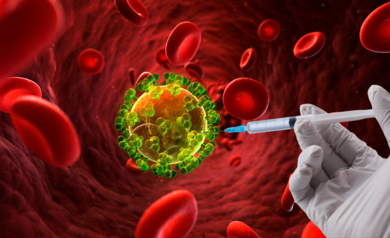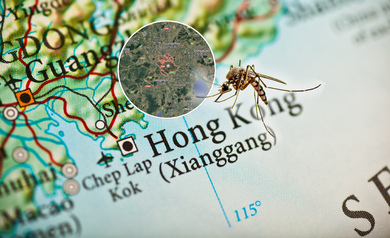- Health Conditions A-Z
- Health & Wellness
- Nutrition
- Fitness
- Health News
- Ayurveda
- Videos
- Medicine A-Z
- Parenting
- Web Stories
Tamim Iqbal Suffers Heart Attack-Can It Be Possible To Predict It Beforehand?

Credit: Canva
Former Bangladesh one-day international (ODI) cricket captain Tamim Iqbal has been hospitalized after he suffered a heart attack on the field during a domestic match. The 36-year-old was leading Mohammedan Sporting Club in a match of the Dhaka Premier League (DPL) on Monday when he complained of chest pain., after which he was rushed to the hospital.
Tariqul Islam, a team official, told a leading media organisation, that Tamim was being treated at a hospital in Savar on Dhaka’s outskirts and urged people to pray for his quick recovery. Meanwhile, the doctors also released an official update wherein they said, "He returned to us in a critical condition. We can call it a heart attack, and we subsequently did an angiogram ( X-ray for blocked arteries) and angioplasty to remove the blockage. The medical procedure has gone smoothly. He is currently under observation. The swift coordination between the medical staff at BKSP and the hospital ensured Tamim was treated quickly."
Can We Predict Heart Attacks?
You can identify a heart attack if the person feels sudden pain or discomfort in the chest, shortness of breath, nausea or sweating. However, several symptoms can occur a month before a person actually suffers a heart attack. They include
1. Chest Pain: A persistent feeling of pressure, tightness, or squeezing in the chest is a hallmark sign that may precede a heart attack.
2. Pain in Other Parts of the Body: Heart attack symptoms aren’t always confined to the chest. Pain may radiate to the arms, jaw, neck, back, or stomach, often described as an aching or heavy sensation.
3. Shortness of Breath: Struggling to catch your breath or feeling out of breath without significant exertion can indicate reduced blood flow to the heart and lungs.
4. Unusual Fatigue: Feeling excessively tired, even after minimal effort, could be a subtle sign of heart trouble.
Why Is Angioplasty Done?
Angioplasty is a procedure that widens blocked or narrowed arteries. It restores blood flow to the heart without open heart surgery. For angioplasty, a long, thin tube (catheter) is put into a blood vessel. It is then guided to the blocked coronary artery. The catheter has a tiny balloon at its tip. Once the catheter is in place, the balloon is inflated at the narrowed area of the heart artery. This presses the plaque or blood clot against the sides of the artery. The result is more room for blood flow.
In recent times, incidences of people suffering from heart attacks while being in the middle of an activity that is physically exerting like running on treadmills, have been repeatedly reported. Iqbal already had blockages in his heart when he was on the field. There is a huge probability that this caused his heart attack.
Wait What! Way Scientists Are Turning To Llamas To Cure Schizophrenia?

Credits: Canva
Schizophrenia, a mental illness involving some 1% of the world's population has long resisted treatments that effectively tackle its cognitive impairments. But a new hero is in the offing, and it's one that few would have predicted: the llama. Scientists at France's Centre National de la Recherche Scientifique have designed short fragments of llama antibody 'nanobodies' that penetrate the blood-brain barrier and restore brain function in mice with schizophrenia-like impairments.
This study, published in Nature on July 23, shows that a single injection into mice can correct memory and behavioral impairments for nearly a week, offering a possible path to therapies that go beyond symptom management.
Existing antipsychotic drugs target hallucinations, delusions, and disorganized thinking—but do little for cognitive symptoms: memory lapses, attention deficits, planning difficulties, and more. These impairments, which often begin in late adolescence or early adulthood, profoundly impact daily life and social integration.
Nanobodies, on the other hand, target the mGlu2 glutamate receptor directly, a neural pathway that is linked to cognitive control. The nanobody derived from llama—herein described as DN13–DN1—is highly specific and will not cause off-target activity, yet it can activate this essential receptor to restore brain signaling equilibrium in NMDA receptor hypofunction models.
One of the hardest problems in brain drug development is the blood–brain barrier—a physiological gatekeeper that blocks most therapies from reaching the brain. Traditional antibodies, although powerful, are too large to pass through.
Nanobodies, which are about one-tenth the size of conventional antibodies, proved to be small enough to permeate this barrier. In this study, they successfully reached brain regions responsible for cognition and maintained therapeutic levels for up to seven days after just one dose.
What Happened in Preclinical Tests?
The researchers tested DN13–DN1 in two mouse models with schizophrenia-like cognitive deficits:
Behavioral improvements: Mice treated with a single injection showed restored memory and decision-making in object recognition and spatial tests.
Sensory gating corrected: Sensorimotor gating—a process that filters out unnecessary stimuli—returned to normal, a function often impaired in schizophrenia.
Long-lasting effect: Benefits persisted for at least a week, far longer than typical drug effects in similar models.
Safety profile: No noticeable impact on basic motor function or brain receptor expression, suggesting a targeted and low-risk mechanism.
What This Means for Schizophrenia Patients?
“For humans obviously we don't know yet—but in mice, it’s sufficient to treat most deficits of schizophrenia,” said molecular biologist Jean-Philippe Pin, one of the study’s senior authors at the Institute of Functional Genomics in Montpellier, France.
If human trials follow the success seen in mice, nanobody-based therapies could extend beyond schizophrenia to other brain disorders that hinge on glutamate signaling—such as Alzheimer’s or Parkinson’s diseases. The researchers themselves emphasize that this is only a proof of concept. Next steps include:
- Humanization of nanobodies to prevent immune rejection
- Long-term safety and toxicity testing
- Large-scale production to meet clinical demand
- Funding and industrial partnerships to support early-phase trials
If all goes well, this research could mark a critical shift in mental health care—delivering medication that directly targets cognitive impairment, not just psychotic symptoms.
What makes this approach so revolutionary is its combination of precision, biodegradability, and ease of administration. Nanobodies are produced more efficiently than traditional antibodies, exert fewer off-target effects, and can be administered via standard injections instead of invasive delivery systems.
Moreover, their ability to cross the blood-brain barrier opens up possibilities for treatments of other neurological disorders—transforming a once-impenetrable challenge into a rapidly evolving frontier.
It’s hard to overstate how unexpected this discovery is: an animal known for its wool, not its neurology, yielding molecules with the potential to heal minds. But that’s exactly where science is advancing today.
As mental health specialists and patients await rigorous human testing, the implications are clear: nanobodies could finally deliver a therapy that addresses schizophrenia’s most stubborn challenges—cognition and quality of life. If the promise of llama-based treatments holds in human trials, we may be on the cusp of a new paradigm in psychiatric medicine—bridging immunology and neuroscience, one nanobody injection at a time.
EU Approves 'Twice Yearly' Injectable HIV Drug To Fight The Virus And Stop Transmission

Credits: Canva
The European Medicines Agency (EMA) has taken a bold step forward in the fight against HIV. On Friday, it recommended the authorization of lenacapavir — an injectable drug shown to be almost 100% effective in preventing HIV transmission. Marketed as Yeytuo in Europe by California-based Gilead Sciences, this drug stands out for its convenience and duration: just two injections per year could prevent infection.
This recommendation is more than just another drug approval. It represents a powerful new tool in a decades-long battle against HIV, one that could fundamentally change how we think about prevention — if access can keep up with innovation.
Once the European Commission rubber-stamps the EMA’s guidance, Yeytuo will be authorized across all 27 EU member states, plus Iceland, Norway, and Liechtenstein. The decision marks a milestone in public health strategy, particularly for populations that face social and logistical barriers to current HIV prevention options.
Unlike existing daily pills or bimonthly injections like cabotegravir, lenacapavir requires just two injections a year. That’s a huge leap in terms of convenience and adherence — and a potential game-changer for people who can’t or won’t take a daily pill due to stigma, forgetfulness, or limited access to healthcare.
The data behind it is strong. In a landmark trial involving nearly 5,000 young women and girls in South Africa and Uganda, not a single participant who received the injection contracted HIV. In contrast, about 2% of those who took daily pills still became infected. The study’s results, published in the New England Journal of Medicine and presented at an AIDS conference in Munich, were so convincing that researchers ended it early to offer lenacapavir to all participants.
“This level of protection is stunning,” said Dr. Salim Abdool Karim, a renowned AIDS researcher based in Durban, South Africa, who was not involved in the study.
The drug is already approved in the U.S., Canada, and Europe as a treatment for HIV. Now, its preventive potential is gaining traction, fast.
More than 40 million people live with HIV globally, and around 630,000 people died from AIDS-related illnesses in 2023 alone, according to UNAIDS. The burden is heaviest in sub-Saharan Africa, Southeast Asia, and the Caribbean — regions that urgently need new prevention tools.
Recognizing this, the World Health Organization (WHO) recently recommended that countries adopt lenacapavir as an additional HIV prevention option, not a replacement. It would complement existing methods like condoms, PrEP pills, and cabotegravir injections.
Winnie Byanyima, Executive Director of UNAIDS, has called lenacapavir “a drug that could change the trajectory of the HIV epidemic,” stressing that equitable access will be key to its success and therein lies the problem.
While Gilead has pledged to allow generic production in 120 low-income countries, it has excluded nearly all of Latin America, where HIV rates remain relatively low but are steadily rising. Critics argue that leaving these regions behind could create new blind spots in the global prevention map — and miss a crucial chance to curb the virus early.
Gilead has defended its access strategy, noting that it's focused on countries with the highest burden. But public health experts warn that rising infections in lower-prevalence regions should not be ignored.
“Ending HIV isn’t just about treating the hardest-hit places. It’s about staying ahead of new outbreaks,” said one international HIV policy advisor who requested anonymity.
Even in countries where the drug may be approved, cost, supply, and health system capacity could hinder rollout — especially in rural or underserved areas. Stigma also remains a significant barrier, deterring many at-risk individuals from seeking preventive care.
Now that the EMA has endorsed lenacapavir for prevention, the European Commission is expected to follow suit, likely within weeks. Approval there would greenlight its use in countries representing nearly half a billion people.
Meanwhile, the U.S. Food and Drug Administration (FDA) approved lenacapavir for prevention earlier this year, and the WHO’s recommendation is expected to guide policies globally but the question remains: will this groundbreaking injectable be made available to the people who need it most — when they need it most?
UNAIDS and other public health advocates are urging a broader global licensing strategy to ensure equitable access. Some have called on leaders — including former President Donald Trump during his term — to broker deals that would fast-track generic production and distribution worldwide.
Lenacapavir’s development is undeniably a breakthrough — scientifically, medically, and logistically. Its six-month dosing schedule reduces clinic visits, lowers the burden of adherence, and offers privacy for people facing stigma. For many, it could be the most realistic prevention option yet but if it remains limited to wealthy countries or a select list of high-burden nations, it won’t fulfill its potential to shift the course of the epidemic. It could become another case study in medical innovation outpacing policy.
With Over 3,100 Infected, Deadly Mosquito-Borne Virus Spreads Rapidly In China—Is It Climate, Travel, Or Both?

Credits: Canva
Foshan city in Guangdong Province is experiencing the country’s largest outbreak of chikungunya, a mosquito-borne viral disease that causes debilitating joint pain, fever, and fatigue. As of July 24, 2025, 3,645 cases have been confirmed—most of them mild, but alarming due to the rapid spread and potential for further outbreaks in surrounding regions.
This surge represents the most significant chikungunya transmission on the Chinese mainland since the virus was first detected there nearly two decades ago.
The epidemic began with an imported case of chikungunya in early July in Shunde District of Foshan, which is roughly 119 kilometers north of Hong Kong. Within weeks, cases ballooned to more than 3,300 in Shunde alone. Chinese officials have not officially attributed the cause, but experts cite favorable climatic conditions—hot and humid that facilitate mosquito breeding—and increased global travel as main drivers.
Chikungunya is transmitted by the Aedes mosquito, most specifically Aedes aegypti and Aedes albopictus. Both insects are famous for their daytime aggression of biting and love for tropical and subtropical regions.
Why Chikungunya Is No Minor Illness Even After All These Years?
The World Health Organization (WHO) defines chikungunya as a disease that is marked by severe joint pain, high fever, and signs and symptoms of headache, muscle pain, rash, vomiting, and fatigue. Though the majority of Foshan cases have been reported as mild, the disabling joint pain of the disease may persist for weeks or even months and can affect daily activities and productivity.
While not usually lethal, chikungunya has the potential to create large-scale public health disturbances, particularly in highly congested urban areas with inadequate mosquito control. To date, no serious or deadly cases have been reported in this outbreak, as indicated by China's Centre for Health Protection (CHP), but public health specialists caution against taking the situation lightly.
How Climate and Travel Are Driving This Outbreak?
Specialized tropical medicine doctors attribute the peak to favorable climatic conditions that promote quick growth of Aedes populations. These are aggressive, day-biting mosquitoes that thrive in warm, wet conditions, noting how climate change plays a major role in expanding habitats for mosquitoes.
Combine this international travel—imported and first case—and lack of immunity in the general population in China, and the stage was set for an outbreak. Chikungunya is not indigenous to China, so there is no herd immunity in the general population, and it was easier for the virus to establish itself and spread rapidly.
Link Between Chikungunya Cases on the Rise Globally
This outbreak is not unique. The European Centre for Disease Prevention and Control (ECDC) has reported 220,000 cases of chikungunya and 80 deaths in 2025 thus far worldwide. The WHO has made a global call to action citing the spread of chikungunya into new regions such as France and Italy, which have each reported locally-acquired infections in 2025.
Over five billion individuals in 119 countries reside in regions exposed to chikungunya infection and thus is considered a global health issue. The tropical diseases of chikungunya, dengue, and Zika are no longer limited to the equatorial belt-they are now reported from temperate regions as well.
To date, Hong Kong—a highly populated international center—has not seen any chikungunya cases after 2020. The territory is not home to Aedes aegypti, the main vector mosquito, but Aedes albopictus, a secondary vector known to spread the disease, is found there. The CHP cautions that imported cases still have the potential to result in local transmission if infected persons are bitten by mosquitoes within their communicable period.
Macao, just south of Guangdong, has registered its first two cases of chikungunya this year, both of them imported from Foshan and nearby Nanhai. Local authorities have stepped up mosquito control as a precaution against possible spread.
How Is China Managing The Outbreak?
With not much else in its bag of tricks, Guangdong Province has increased mosquito control operations, encouraging residents to clear standing water, unblock choked drains, and observe simple household sanitation. This is essential in interrupting the mosquito life cycle because still water provides a breeding ground for Aedes mosquitoes.
The CHP also recommends applying insect repellents, especially containing DEET or other WHO-recommended active compounds, and wearing long-sleeved clothing, especially in the early morning and late afternoon when mosquitoes are most prevalent.
The United States has only two licensed chikungunya vaccines, recommended mainly for visitors going to outbreak areas. However, China also doesn't have these vaccines available, which makes its citizens susceptible to successive waves unless mass vaccination is implemented or localized vaccines are created.
This leaves health authorities with few options: mosquito control, public awareness, and early diagnosis remain the main line of defense for the time being.
This epidemic is a clear message. Diseases such as chikungunya no longer remain isolated in small enclaves of tropical countries. With the climate still rising and international travel recovering after the pandemic, infectious disease is set to travel quicker and more far-reaching than ever before.
Dr. Tsui, a Guangdong public health official, explained in a press statement that chikungunya has the potential to quickly blow into large-scale outbreaks, particularly in highly populated regions with low mosquito densities and little immunity. The burden on healthcare systems, particularly in fast-growing urban areas of Asia, is a legitimate and increasing concern.
© 2024 Bennett, Coleman & Company Limited




